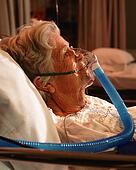Patients with chronic obstructive pulmonary disease (COPD) experience, on average, acute exacerbations about once per year. These events are severe, often require admission to the hospital, and carry a significant risk for mortality. High-concentration oxygen is commonly administered as soon as the diagnosis of an acute exacerbation is made. However, is it safe to administer high concentrations of oxygen to patients who may have elevated arterial CO2 levels and respiratory acidosis caused by ventilatory failure?

A study performed in Australia randomly assigned 405 patients with acute exacerbations of COPD to receive oxygen by nasal prongs at either 8-10 L/min (high-flow) or by a flow rate that was titrated to increase the arterial oxygen saturation just to 88%-92% (titrated flow). The primary outcome, mortality from the time of diagnosis through hospitalization (by intention to treat), was 9% in the high-flow patients and 4% in the titrated flow patients (P < .02), giving a number needed to treat of 19 patients to save 1 life. Secondary outcomes, the change in arterial blood gases, showed that titrated flow patients experienced a relative improvement in pH and pCO2 compared with those on high-flow oxygenation.
The conclusion was that titrating oxygen administration to adequate levels, as recommended in guidelines, is safer than administering oxygen at high flow rates to patients with COPD who may have "acute-on-chronic" respiratory failure.

A study performed in Australia randomly assigned 405 patients with acute exacerbations of COPD to receive oxygen by nasal prongs at either 8-10 L/min (high-flow) or by a flow rate that was titrated to increase the arterial oxygen saturation just to 88%-92% (titrated flow). The primary outcome, mortality from the time of diagnosis through hospitalization (by intention to treat), was 9% in the high-flow patients and 4% in the titrated flow patients (P < .02), giving a number needed to treat of 19 patients to save 1 life. Secondary outcomes, the change in arterial blood gases, showed that titrated flow patients experienced a relative improvement in pH and pCO2 compared with those on high-flow oxygenation.
The conclusion was that titrating oxygen administration to adequate levels, as recommended in guidelines, is safer than administering oxygen at high flow rates to patients with COPD who may have "acute-on-chronic" respiratory failure.



 8:07 AM
8:07 AM
 Unknown
Unknown

 Posted in:
Posted in:
0 comments:
Post a Comment